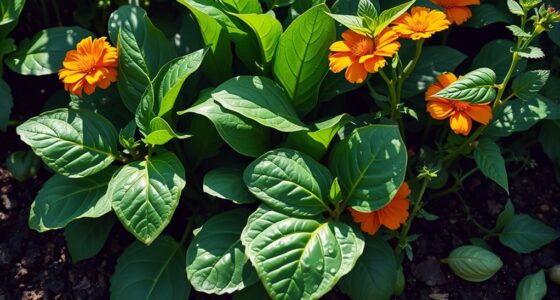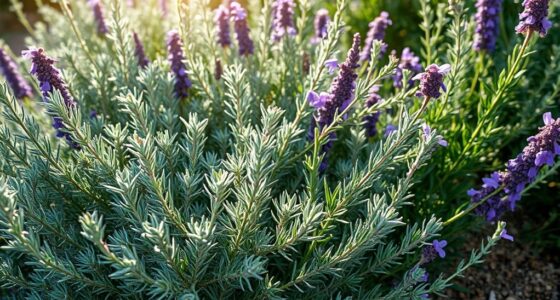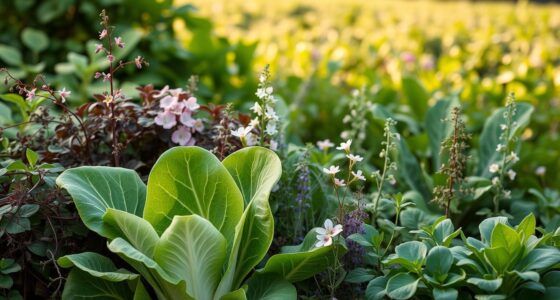As you step into your garden, there’s a special thrill that accompanies the first signs of spring. The earthy aroma of rich soil, the promise of vibrant green leaves, and the joy of watching your seeds sprout into healthy plants all weave together to create a heartfelt connection to nature. For many, including you, gardening is not just a hobby but a nurturing embrace—a moment where you can cultivate not just vegetables, but also peace of mind. And in this journey, understanding the art of companion planting with broccoli can be the secret to unlocking a thriving garden. When you choose the best companions for broccoli, you forge relationships among plants that elevate their growth and health while adding vitality to your garden ecosystem. Together, let’s explore the top broccoli companion plants to grow now, so you can create a flourishing oasis right in your backyard.
Key Takeaways
- Broccoli thrives with the right companion plants, enhancing its growth and health.
- Companion planting with broccoli can reduce pests and diseases effectively.
- Choosing the best companions for broccoli fosters soil health.
- Understanding plant relationships leads to a more productive garden.
- Your garden can become a biodiversity hotspot through thoughtful pairing.
Why Companion Planting Matters for Broccoli
Companion planting serves as a fundamental gardening practice that can significantly enhance your broccoli’s health and productivity. Understanding the benefits of companion plants allows you to create a thriving garden environment where vegetables flourish. When selecting plants to grow alongside broccoli, consider choices that not only benefit your broccoli directly but also contribute to an overall balanced ecosystem.
Benefits of Companion Planting
Implementing companion planting offers a variety of advantages, including improved pest control, optimized nutrient uptake, and healthier crops. By pairing broccoli with beneficial plants, you can create a natural defense system against common threats. These companion plants can also enhance soil quality, leading to better growth and yield.
Reducing Pests and Diseases
Using specific companion plants can effectively minimize the prevalence of pests that attack broccoli. For example, interplanting with flowering herbs such as dill or coriander attracts beneficial insects that prey on harmful pests like aphids and cabbage loopers. This form of broccoli and pest control not only helps protect the plants but significantly reduces the need for chemical interventions.
Enhancing Soil Health
Companion plants play a crucial role in improving the overall health of your garden’s soil. Some plants fix nitrogen in the soil, providing essential nutrients that broccoli thrives on. This results in richer, more fertile ground that supports robust root systems and promotes strong plant growth. Integrating these practices makes your gardening efforts not only fruitful but sustainable.

Ideal Soil Conditions for Broccoli
To successfully grow broccoli, understanding the ideal soil conditions is crucial. Focus on maintaining an environment that fosters healthy plant growth and optimum yields. Taking care of soil pH, nutrient content, and watering practices will make a significant difference in your broccoli gardening journey.
Soil pH Requirements
The ideal pH for broccoli ranges from 6.0 to 7.0. This specific range helps ensure that nutrients remain available for the plant’s absorption. Testing your soil before planting is essential, as it can indicate whether amendments are necessary to reach this optimal pH level.
Nutrient Needs
Broccoli thrives in nutrient-rich soil. Key nutrients include nitrogen, calcium, and potassium. Enriching your soil with compost and organic fertilizers can dramatically improve both the nutrient profile and overall health of your broccoli plants. Regular soil testing will help you monitor nutrient levels and make timely adjustments.
Watering Techniques
Properly watering broccoli plants is fundamental for achieving robust growth. Consistent moisture during the initial weeks after planting is critical. Opt for deep, infrequent watering to encourage strong root development. This approach ensures your broccoli not only survives but flourishes in its growing environment.

| Nutrient | Function | Sources |
|---|---|---|
| Nitrogen | Promotes leafy growth | Compost, legumes |
| Calcium | Strengthens cell walls | Gypsum, lime |
| Potassium | Enhances overall plant health | Wood ash, organic fertilizers |
Companion Plants That Thrive with Broccoli
When planning your broccoli garden, consider incorporating companion plants that provide various benefits. Some of these plants not only coexist well with broccoli but enhance its growth and health. Discovering which plants grow well with broccoli can lead to a more productive garden.
Spinach: A Perfect Match
Spinach serves as a fantastic spinach companion plant. The large leaves of broccoli offer ample shade, allowing spinach to thrive during warmer months. Both crops share similar water and nutrient requirements, ensuring they complement each other effectively in the garden.
Beets: Nutrient-Rich Neighbors
Beets represent one of the nutrient-rich companions for broccoli. They absorb different nutrients from the soil than broccoli, reducing competition for vital resources. This harmonious relationship benefits both plants, resulting in healthier crops overall.
Marigolds: Natural Pest Deterrents
Integrating marigolds into your broccoli garden can act as a natural pest deterrent. These cheerful flowers repel harmful insects that may attack your broccoli, fostering a healthier and more balanced ecosystem. This unique companion planting strategy creates an environment where both crops can thrive.

Herbs That Benefit Broccoli Growth
Incorporating herbs that are good for broccoli can significantly enhance your garden’s ecosystem. Companion herbs, such as basil and oregano, provide various benefits to your flourishing broccoli plants. These aromatic herbs not only elevate the flavor of your dishes but also contribute to healthier growth and pest resistance.
Basil: Aromatic Enhancement
Basil with broccoli is a winning combination for any garden enthusiast. This fragrant herb not only complements broccoli in culinary applications but also serves to deter various pests. The strong aroma of basil masks the scent of broccoli, making it less detectable to harmful insects. Additionally, basil promotes the overall health of nearby plants, ensuring that your broccoli thrives.
Oregano: Pest Repellent Properties
Oregano stands out as another excellent addition to your broccoli plants. This herb features insecticidal qualities that make it effective in repelling pests while supporting the health of companion herbs. Oregano encourages stronger growth in broccoli by creating a resilient environment. When planted together, basil and oregano work in harmony, providing an ideal setting for your broccoli to flourish.

Flowering Plants That Pair Well with Broccoli
Incorporating flowering plants into your broccoli garden can enhance aesthetics and plant health. Flowering companions for broccoli, such as nasturtiums and sunflowers, provide numerous benefits beyond visual appeal. These vibrant plants can attract beneficial insects and deter pests while creating a dynamic garden environment.
Nasturtiums: Colorful Companions
Nasturtiums offer a range of advantages that significantly benefit your broccoli crops. These flowering plants act as trap crops, luring pests away from broccoli and other brassicas. An attractive bloom, nasturtiums not only beautify your garden but also help reduce the chances of caterpillar infestations. The nasturtiums benefits extend to enhancing biodiversity, which contributes to a healthier ecosystem around your vegetables.
Sunflowers: Attracting Pollinators
Sunflowers and broccoli complement each other remarkably. Sunflowers bring vibrant color and attract essential pollinators to your garden, which is vital for overall plant health and improved yields. By incorporating sunflowers, you can create a lively atmosphere that enriches the surrounding environment. This symbiotic relationship aids the development of your broccoli while supporting the pollinator populations crucial for many garden tasks.

Vegetables to Avoid Planting Near Broccoli
When planning your broccoli garden, it’s important to consider the types of plants you choose to grow nearby. Certain vegetables can hinder the growth of broccoli or attract unwanted pests. Understanding which plants to avoid with broccoli will help you maintain a healthy and productive garden.
Nightshade Family: A Cautionary Tale
The nightshade family, including tomatoes and peppers, falls under the list of broccoli garden companions to avoid. These plants compete for similar nutrients and share common vulnerabilities to pests. Planting nightshade varieties close to your broccoli can invite nightshade pests, impacting the overall yield of your garden. Keeping these plants at a distance will allow your broccoli to flourish without the stress of competition.
Strawberries: Nutrient Competition
While strawberries are beloved in many gardens, they should not share space with broccoli. These two plants compete for nutrients, which can lead to stunted growth for your broccoli. To ensure optimal growth and health, consider isolating strawberries from your broccoli plants. This strategy will facilitate better nutrient absorption and result in brighter, healthier crops.

Companion Planting Strategies for Broccoli
Using companion planting strategies can significantly enhance your broccoli cultivation. These techniques involve growing different crops close together to make the most of available space and resources, leading to healthier plants and increased yields. One effective method is intercropping with broccoli, which allows for synergistic growth patterns that benefit both plants in proximity.
Intercropping Techniques
When applying intercropping with broccoli, consider pairing it with faster-growing crops. For example, you can plant radishes alongside your broccoli. This pairing not only maximizes space but also minimizes the risk of pests. The quicker growth of radishes allows them to establish themselves before broccoli starts to take up more space in the garden. This strategy helps prevent competition for nutrients and ensures that both plants thrive.
Timing for Planting
The timing of broccoli planting plays a vital role in successful gardening outcomes. It is best to plant your companion crops at staggered intervals so that they support one another throughout their growth cycles. Timing broccoli planting correctly helps avoid overcrowding, which can lead to nutrient competition and stunted growth. Plan to sow your radishes and other companions a few weeks before or after your broccoli, depending on their growth rates. This thoughtful approach ensures optimal conditions for both plant types.

Benefits of Growing Broccoli with Legumes
Incorporating legumes that benefit broccoli is an excellent way to enhance soil fertility and support healthy plant growth. Both peas and beans provide significant advantages when interplanted with broccoli. Understanding how these legumes contribute to broccoli growth will encourage you to include them in your garden.
Peas: Nitrogen Fixation
Growing peas with broccoli is a smart strategy. Peas are capable of fixing nitrogen from the atmosphere into the soil, enriching it with this essential nutrient. As the peas grow, they help create a nutrient-rich environment that supports not only their own development but also that of the broccoli nearby. This symbiotic relationship fosters vigorous growth and improved yields.
Beans: Soil Enrichment
Beans for soil health make a noticeable difference in your garden. When planted with broccoli, beans further enhance the soil by adding organic matter and improving soil structure. As they decompose, they release nutrients, which boosts the overall health of the soil. This dynamic pairing promotes robust broccoli plants capable of thriving in a well-balanced environment.
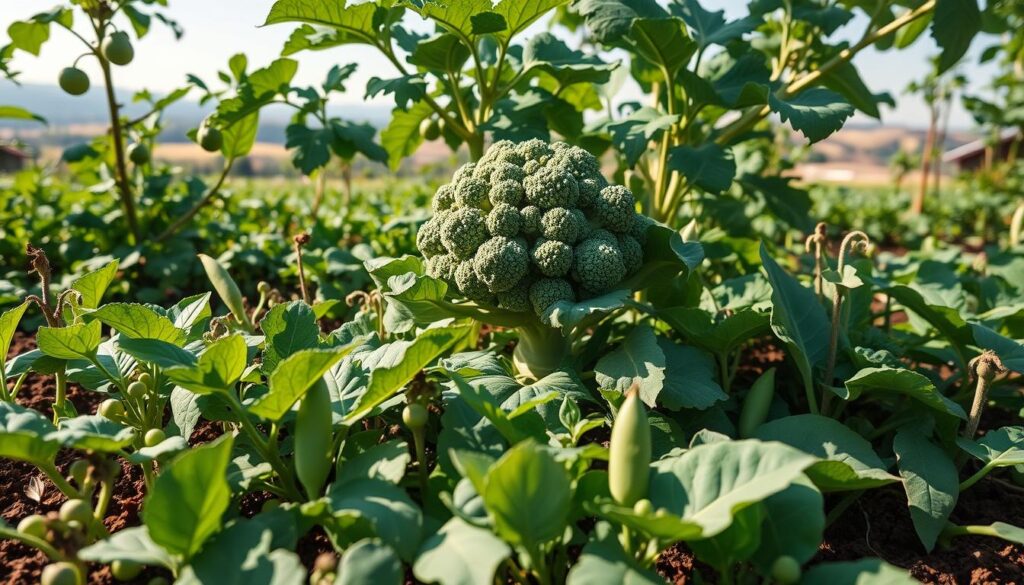
Fostering Biodiversity in Your Garden
Building a rich and diverse garden can significantly enhance your gardening experience. Fostering biodiversity not only aids in creating a vibrant ecosystem but also serves to attract beneficial insects for broccoli, helping to maintain a healthier crop overall. A well-balanced garden ecosystem supports various plant species, which in turn promotes the presence of natural pest control agents.
Attracting Good Bugs
Incorporating a variety of plants encourages the arrival of beneficial insects such as ladybugs, lacewings, and predatory wasps. These insects play an essential role in keeping harmful pests at bay. By planting flowers like yarrow or dill alongside your broccoli, you can create attractive habitats, inviting these helpful bugs to your garden. This method contributes to a garden ecosystem balance, ensuring that pests are kept under control naturally.
Balancing Ecosystems
A diverse range of plants achieves more than just aesthetics; it can create a complex chain of interactions in your garden. Various plants contribute different nutrients back into the soil, improving its overall health. When combined, these plants support diverse microbial communities, beneficial insects for broccoli, and other organisms crucial for maintaining a harmonious environment. The end result is a flourishing garden where all elements coexist productively.

Seasonal Considerations for Broccoli Companions
Understanding the timing of seasonal planting for broccoli can significantly improve your garden’s yield. Spring broadcasting allows you to plant cool-weather companions such as spinach and lettuce. These plants flourish in the early months, setting the stage for a robust broccoli harvest later on. Transitioning into the fall, consider how your strategies adapt to nurture another set of companions.
Spring Planting Tips
During spring, the temperature is conducive for the growth of several beneficial plants alongside broccoli. Consider the following tips for effective planting:
- Opt for quick-maturing options like spinach, which can be harvested before broccoli fully matures.
- Incorporate lettuce to benefit from similar growing conditions, ensuring efficient use of garden space.
- Pay attention to soil health, enriching it with compost before planting your companions.
Fall Planting Strategies
As the season shifts to fall, revisit your planting tactics for an effective harvest. Here are some valuable fall harvesting tips:
- Choose nutrient-rich crops such as kale and beans that thrive in cooler temperatures during these months.
- Employ good spacing techniques to allow for optimal growth and air circulation among plants.
- Monitor weather conditions closely to safeguard against unexpected frosts.

Adjusting your planting strategies based on seasonal changes ensures a flourishing broccoli garden. Implement these tips to maximize your yields throughout the growing seasons.
How to Manage Space for Companion Plants
Effectively managing space for broccoli and its companion plants can lead to a more productive garden. Incorporating techniques such as succession planting and vertical gardening can optimize your available space, ensuring that every inch is utilized. By staggering planting times and allowing plants to grow upwards, you can create a flourishing garden environment.
Succession Planting
Succession planting strategies allow you to harvest crops over an extended period. This method involves replanting crops in the same area after the previous ones have been harvested. For broccoli, choose companion crops that mature quickly. This approach ensures that you maximize your space efficiently, making the most of your growing season.
- Sow fast-maturing plants like radishes or lettuce shortly after harvesting broccoli.
- Consider timing and climate to stagger harvests effectively.
- Rotate crops to maintain soil health and reduce pest issues.
Vertical Gardening Techniques
Using vertical gardening for companion plants can significantly enhance your garden’s layout. By allowing certain plants to grow upwards, you free up ground space for larger crops like broccoli. This technique not only optimizes area but also improves air circulation and access to sunlight.
- Install trellises to support climbing plants such as peas or beans.
- Utilize wall-mounted planters to maximize vertical space.
- Choose companion plants that can thrive in a vertical setup alongside broccoli.
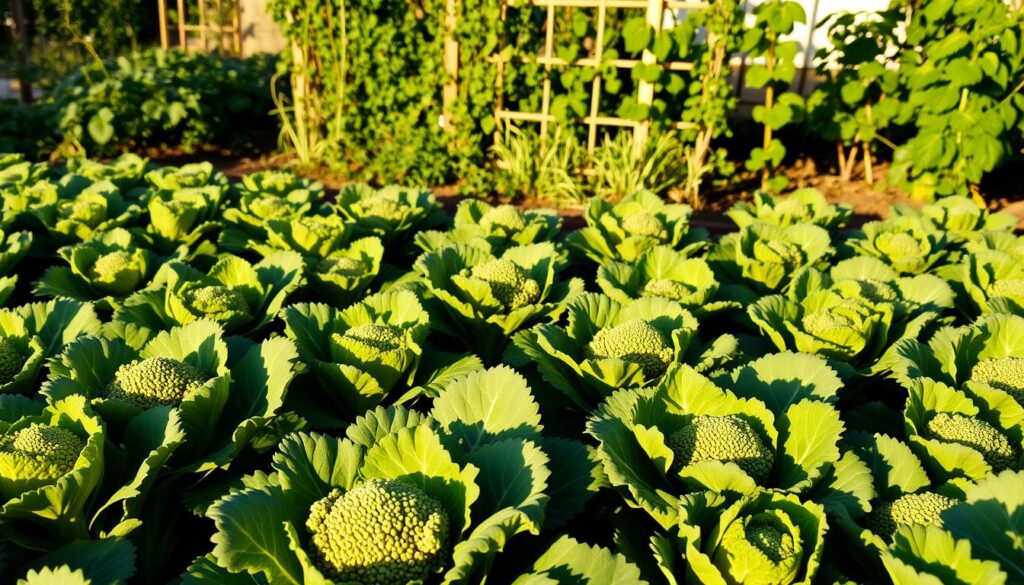
Nutrient-Rich Companion Plant Suggestions
Finding the right companions for your broccoli can significantly enhance your garden’s productivity. Two standout options are garlic and radishes, both known for their positive impacts on broccoli growth. By incorporating these nutrient-rich companions for broccoli, you can create an even more robust growing environment.
Garlic: Health Benefits
Garlic and broccoli make an exceptional pairing. The strong scent of garlic acts as a natural pest repellent, helping protect broccoli from common garden invaders. In addition to enhancing flavor in your kitchen, garlic supports healthy growth in your vegetable patch by minimizing pest-related stress. This partnership can lead to a healthier crop overall.
Radishes: Quick Harvest
If you’re looking for fast results, radishes for quick yield are hard to beat. These vibrant vegetables can be sown between your broccoli plants and will reach maturity in just a few weeks. This allows you to harvest radishes before broccoli requires more space, preventing resource competition and making the most of your garden area.

Creating a Pollinator-Friendly Garden
To cultivate a thriving broccoli garden, you need to consider the pivotal role of pollinators. These creatures, including bees and butterflies, contribute to the successful growth of a variety of plants, especially broccoli. Establishing a pollinator-friendly garden can greatly improve your gardening experience.
Why Pollinators Matter
Pollinators are essential in helping many fruits and vegetables set seeds and produce more robust yields. They facilitate the process of fertilization by transferring pollen from one flower to another, which directly correlates to the productivity of your broccoli plants. Understanding the benefits of pollinators for broccoli can significantly impact the success of your harvest.
Choosing Pollinator-Friendly Companions
When aiming at attracting pollinators, consider incorporating a variety of flowering plants that can coexist beautifully with your broccoli. Examples of effective pollinator-friendly garden plants include:
- Borage: This vibrant herb attracts bees and improves the pollination of nearby crops.
- Lavender: Its fragrant blossoms not only draw pollinators but also enhance your garden’s aesthetics.
- Sunflowers: These tall beauties are excellent at luring in various pollinators while providing shade to your vegetables.
By strategically positioning these plants near your broccoli, you can create a lively environment that encourages attracting pollinators, thereby maximizing your gardening success.

Sourcing Companion Plants: Where to Buy
Finding the right sources for companion plants can significantly enhance your broccoli garden. You can choose between local nurseries for broccoli or opt for the convenience of online plant shopping. Each option offers unique benefits that cater to various gardening needs.
Local Nurseries vs. Online Stores
Local nurseries for broccoli often provide robust, healthy plants that are acclimated to your specific region. By purchasing from nearby sources, you contribute to the local economy and may receive valuable advice from knowledgeable staff. In contrast, online plant shopping opens up a broader range of options, allowing access to specialized or rare plants that may not be available locally. Quality and shipping times can vary, so consider your preferences when deciding.
Seed Saving Tips
Saving seeds from your favorite plants each season can be a rewarding practice. This ensures you have a continual supply of companion plants tailored to your garden’s needs. Be sure to gather seeds from the healthiest and most productive specimens. Document the source of the seeds and their specific qualities to help refine your choices for future planting seasons.
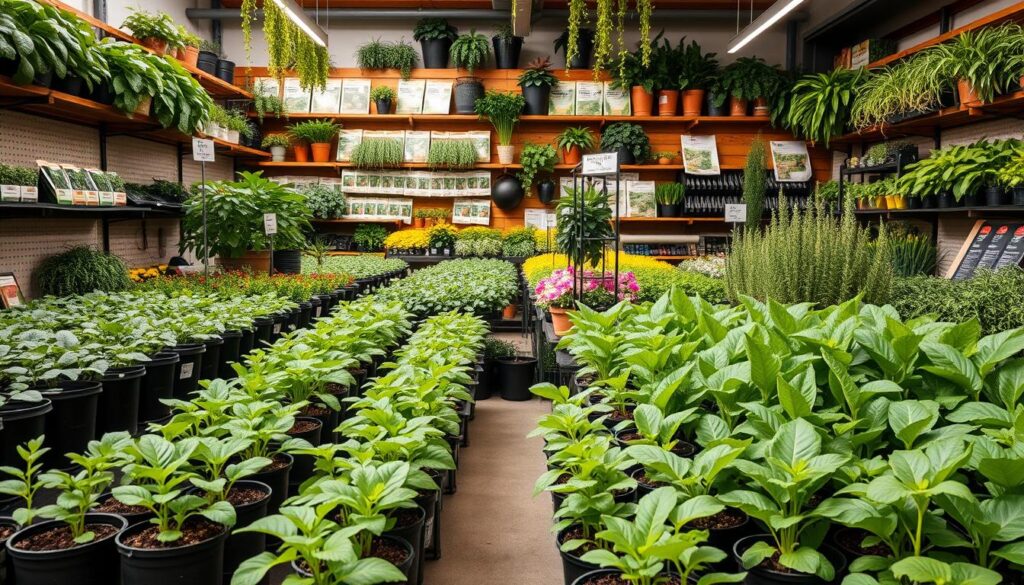
Companion Planting Myths: Separating Fact from Fiction
Understanding the myths of companion planting can significantly enhance your gardening approach. Few realize that not all plants grow well together, leading to common misconceptions about which pairs yield the best results. By examining facts about companion plants, you’ll gain insights that help you make informed choices for your garden.
Common Misconceptions
A prevalent myth suggests that planting any two species together will result in positive growth. This is not always true. Some plants compete for nutrients or attract harmful pests. Knowing which plants work harmoniously can help you avoid these pitfalls. Misunderstanding these dynamics can lead to poor plant health and yield.
Understanding Your Plants
Understanding broccoli needs is essential for successful companion planting. Broccoli thrives with specific companions that can enhance its growth while minimizing stress from pests and diseases. Research your selected plants to align their needs with broccoli’s preferences. This will foster a robust garden where each plant supports the other.

| Myth | Fact |
|---|---|
| All plants grow well together | Some plants compete for nutrients or attract pests |
| Companion planting requires no research | Understanding specific plant needs is crucial for success |
| Only a few plants are beneficial | Many combinations support better growth and health |
Monitoring Plant Health and Growth
Regular monitoring of plant health is crucial for the success of your broccoli garden. Keeping an eye on both your broccoli and its companions allows you to catch early signs of issues that could hinder growth. By observing your plants closely, you can identify compatibility issues for broccoli and make the necessary adjustments for garden health.
Signs of Compatibility Issues
As you cultivate your garden, look for specific signs that may indicate compatibility issues among your plants. Consider watching for:
- Yellowing leaves: This can suggest nutrient deficiencies or stress.
- Stunted growth: If plants fail to thrive, it may be a sign of detrimental relationships with nearby plants.
- Pest infestations: Some companions may attract pests that could adversely affect broccoli.
Adjustments You Can Make
If you notice any symptoms of distress, various adjustments can improve your garden’s health. Consider implementing these strategies:
- Spacing alterations: Increase space between plants to improve air circulation.
- Watering changes: Ensure consistent moisture without overwatering.
- Choosing different companions: Opt for plants that are known to support broccoli growth.

Conclusion: Achieving a Thriving Broccoli Garden
As you embark on your journey toward a thriving broccoli garden, it’s essential to recap the benefits of companion planting. By selecting the right companion plants, you can enhance the growth and flavor of your broccoli while deterring pests and diseases. From legumes nitrogen-fixing abilities to aromatic herbs that improve taste, the right companions create a harmonious ecosystem that promotes healthy development in your garden.
Now that you are equipped with strategies and insights on companion planting, it’s time to consider the next steps for gardening. Begin by choosing suitable companions based on the principles outlined in this article. Whether you decide to plant peas alongside your broccoli or integrate vibrant marigolds, your efforts will pay off. With patience and dedication, you’ll nurture a flourishing garden that yields delightful and nutritious crops.
Remember that achieving success in your gardening endeavors requires observation and adaptation. Monitor plant health and take action to resolve any compatibility issues. As you implement these practices, you’ll not only enjoy the benefits of companion planting but also create a thriving broccoli garden that showcases the fruits of your labor and commitment.


